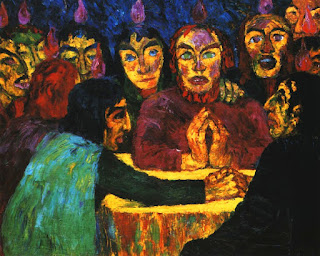Artist: Emil Nolde
Medium: Oil on canvas
Size: tbd.
Date: 1909
Location: Neue Nationalgalerie, Berlin.
Acts of Apostles 2:1-4 When the Day of Pentecost had fully come, they were all together in one place. And there was suddenly out of heaven a sound, as of a rushing mighty wind, and it filled the whole house where they were sitting. Then there appeared to them dividing tongues, as of fire, and one sat upon each one of them. And they were all filled with the Holy Spirit and began to speak with other tongues, as the Spirit gave them utterance.
Pentecost, the Feast of the Firstfruits, was a most appropriate time for the Spirit to come. The Feast was closely connected with Passover, just as the Spirit's coming would be connected with the saving events of the Lord's crucifixion and exaltation. The divine origin and supernatural character of the event is clear: the sound is from heaven and is like a violent wind, the tongues that appear seemed to be flames of fire. In the Old Testament such a loud sound often accompanied a theophany (Ex 19:16, 19; 20:18). A violent, rushing wind symbolizes the Holy Spirit (Ezek 37:9-14). The sound fills the whole house. What has arrived is an all-encompassing divine presence, and tongues like flames of fire also symbolize the Spirit of God, especially his power.
Emil Nolde (August 1867 – April 1956) was a German painter and printmaker. He was one of the first Expressionists and a member an influential group of German expressionist artists formed in Dresden. This painting, however, became the center of a row that split the Berlin Secession—one, of the most advanced exhibiting societies in Germany up until that time. Nolde’s primitivist treatment of this religious subject, rendered in glowing colors and bold, Expressionist brushwork, found little favor among the older members of the society. When Pentecost and the works of other younger artists were rejected, Nolde attacked the leadership and principles of the Secession in an open letter to its President, whereupon he was expelled from the association. Until 1912 he exhibited alongside other rejected artists in the Neue Sezession in Berlin.


